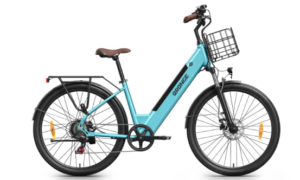Electric bikes, commonly known as e-bikes, have revolutionized the cycling world, offering riders an efficient and eco-friendly mode of transportation. Powered by a battery-powered motor, these bikes provide an extra boost to pedal power, making them suitable for commuting, recreational rides, and even off-road adventures.
Amidst the diverse range of e-bike options available, tire selection is a critical consideration. The choice between fat tires and thin tires plays a pivotal role in determining the bike’s performance and versatility. Tires not only affect traction and stability but also dictate the terrain an e-bike can conquer.
This blog aims to explore the differences between fat tires and thin tires for e-bikes, helping riders understand the implications of their choice and make informed decisions when selecting the perfect electric ride.
Exploring Fat Tires: Everything You Need to Know
Fat tires, distinguished by their wide profile typically ranging from 3.8 to 5 inches in width, are a distinctive feature of certain electric bikes. Their broader surface provides unique advantages across a variety of terrain types. Check out, Himiway’s Fat Tire e-bikes, for a better understanding.
Advantages of Fat Tires
● Stability on Various Terrains
Fat tires excel in navigating challenging landscapes such as sand, snow, mud, and rocky trails. Their ample surface area distributes weight evenly, enhancing stability and reducing the risk of slipping or sinking.
● Enhanced Traction
The wider tread pattern of fat tires ensures superior traction, particularly in loose or slippery conditions. This feature is invaluable for off-road excursions where maintaining control is paramount.
● Comfortable Ride
Fat tires offer a plush and smooth riding experience, absorbing shocks and vibrations from uneven surfaces. This enhanced shock absorption translates to a more enjoyable journey, especially during extended rides.
Disadvantages of Fat Tires
● Increased Weight
The additional rubber and material required to construct fat tires contribute to their weightiness. This added mass can pose challenges when maneuvering the bike, particularly in tight spaces or on steep terrain.
● Slower Speed on Smooth Surfaces
Fat tires generally result in slower speeds on smooth, paved surfaces compared to narrower counterparts. Cyclists may experience reduced efficiency and speed when riding on roads or bike paths.
● Higher Rolling Resistance
Fat tires inherently offer higher rolling resistance due to their larger surface area in contact with the ground. As a result, cyclists may need to exert more effort to maintain speed, especially on flat surfaces.
Exploring Thin Tires: Everything You Need to Know
Thin tires, typically ranging from 1 to 2 inches in width, are a defining feature of certain electric bikes. Their sleek profile offers distinct advantages, particularly on smooth surfaces.
Advantages of Thin Tire
● Lightweight Design
Thin tires are significantly lighter than their fat counterparts, contributing to a more agile and responsive ride. This reduced weight facilitates easier maneuverability, especially during quick turns or changes in direction.
● Higher Speed on Smooth Surfaces
The narrow profile of thin tires minimizes contact with the ground, resulting in less rolling resistance and enabling higher speeds on smooth, paved surfaces such as roads and bike paths.
● Lower Rolling Resistance
Thin tires require less effort to pedal due to their smaller contact area with the ground. This lower rolling resistance translates to improved efficiency and energy conservation, making long rides more manageable.
Disadvantages of Thin Tire
● Reduced Stability on Rough Terrain
Thin tires lack the surface area and tread depth needed to maintain stability on rough or uneven terrain. Riders may experience difficulties navigating gravel, dirt trails, or other challenging landscapes.
● Limited Traction
The narrower tread pattern of thin tires offers less traction, particularly in slippery or wet conditions. This reduced grip may compromise control and increase the risk of sliding, especially during cornering or braking.
● Less Comfortable Ride
Thin tires provide minimal shock absorption compared to fat tires, resulting in a bumpier and less comfortable ride, especially on rough surfaces. Cyclists may experience increased vibrations and road feedback, leading to fatigue over extended periods of ridiTires
Factors to Consider When Choosing Between Fat and Thin Tires
When deliberating between fat and thin tires for your e-bike, several factors come into play to ensure the perfect fit for your riding needs and preferences:
Terrain and Riding Conditions
Consider the predominant terrain and riding conditions you’ll encounter. Fat tires excel on rough, uneven surfaces like trails, sand, and snow, offering enhanced stability and traction. In contrast, thin tires are better suited for smooth, paved surfaces such as roads and bike paths, where they deliver superior speed and efficiency.
Riding Style and Preferences
Your riding style and preferences play a crucial role in tire selection. If you enjoy off-road adventures and prioritize comfort and control, fat tires may be the preferred choice. On the other hand, if you prefer high-speed rides on paved surfaces and prioritize agility and responsiveness, thin tires might be more suitable.
Weight and Size Considerations
Consider the weight and size of the tires in relation to your e-bike’s overall weight and dimensions. Fat tires tend to be heavier and bulkier, which can affect maneuverability and acceleration, especially for smaller riders or those with limited strength. Thin tires offer a lightweight and streamlined option, ideal for riders seeking agility and ease of handling.
Maintenance Requirements
Factor in the maintenance requirements associated with each tire type. Fat tires typically require less maintenance due to their robust construction and ability to withstand rugged terrain. Thin tires, while offering lower rolling resistance, may be more susceptible to punctures and wear, necessitating more frequent inspections and replacements.
By carefully assessing these factors, you can make an informed decision when choosing between fat and thin tires for your e-bike. You have lots of choices around you to choose from. Let me suggest some options which are appreciated by the customers around the world.
Himiway Cruiser
The Himiway Cruiser is a formidable long-range electric bike designed for both urban commutes and off-road adventures. With a powerful 750W motor and a robust 48V 17.5Ah battery, this e-bike offers an impressive range of up to 60 miles on a single charge. Its 26″x4″ fat tires provide excellent traction and stability across various terrains, while its 350 lbs payload capacity ensures versatility for riders of all sizes.
Himiway Zebra
Introducing the Himiway Zebra, a rugged and versatile electric bike designed to tackle any terrain with ease. Featuring 26”×4″ fat tires, this e-bike is equipped with a powerful 250W motor and a high-capacity 48V 20Ah battery, providing an impressive range of up to 80 miles on a single charge. With a payload capacity of 400 lbs, the Himiway Zebra accommodates riders of all sizes and offers ample storage options for gear or groceries.
Conclusion
In conclusion, the decision between fat tires and thin tires for your e-bike ultimately boils down to your personal preferences, riding style, and intended use. Both tire types offer distinct advantages and cater to different riding needs, whether you prioritize stability and comfort on rough terrain or seek speed and efficiency on paved surfaces.
However, regardless of your tire preference, it’s essential to choose a reliable and high-quality e-bike that meets your expectations. In this regard, Himiway e-bikes stand out as exceptional options. With their durable construction, powerful motors, and long-lasting batteries, Himiway e-bikes deliver exceptional performance and reliability across a variety of terrains.



































